| Image Soon |
Lemon
Grass (Cymbopogon citratus) |
| Image Soon |
Rocambole
(Allium scorodoprasum) A prized culinary herb! A perennial with
unusual twisted stems and edible aerial bulblets. All
parts of this plant produce a mild garlic flavor
- Culinary:
A mild garlic flavor gives this onion related
herb its popularity. Used frequently in French
and Italian cooking. The flowers develp edible
bulbs.
- Medicinal:
Contains iron and vitamins. A mild antibiotic.
Like all Alliums, it contains sulphur oil which
helps lower blood pressure.
|
| Image Soon |
Rosemary
(Rosmarinus officinalis) Rosemary is an attractive evergreen shrub
with elongated leaves. Praised in the past for the powers
it was thought to posess, and was closely related to the
church.
- Culinary:
Roasted poultry, fish, and meats are great with
the addition of rosemary. A minty pine taste
enhances all kinds of vegetables. Marinades,
vinegars, dressings and sauces.
- Medicinal:
The oil derived from the flowers and foliage is
considered a carminative. Used in pharmacies
today. The oil is also thought to help with pain,
bruises, wounds, and soars when gently massaged
into the wounded areas. Also has some
antibacterial effects to help in the fight
against germs.
- Aromatic:
The minty pine scent is very distinctive. Baths
are drawn with rosemary to help lift the spirits
and relax the body. Rosemary in clothes drawers
is said to deter moths and scent the clothes. Oil
is added to soaps, creams, and perfumes for its
pine scent.
- Ornamental:
Evergreen lance-shaped foliage gives a handsome
effect to the plant. Blue flowers decorate the
plant throughout the summer. Popular in many
gardens.
- Full Sun
- 4-6 feet in height.
- Frozen rosemary is
stronger than fresh rosemary.
- Tender perennial.
- Well-Drained soil.
|
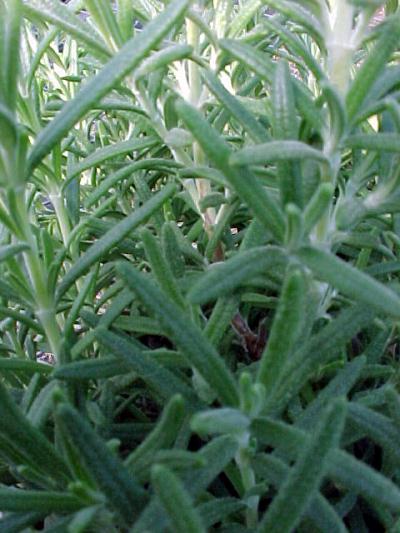 |
Rosemary, Arp (Rosmarinus
officinalis) Not
very different from the straight rosemary. Maybe a bit
thinner foliage with a hint of grey. Mainly the same
habits and uses, yet found in a cold temperate zone, and
thought of as the hardiest of all rosemary.
- Culinary:
Roasted poultry, fish, and meats are great with
the addition of rosemary. A minty pine taste
enhances all kinds of vegetables. Marinades,
vinegars, dressings and sauces.
- Medicinal:
The oil derived from the flowers and foliage is
considered a carminative. Used in pharmacies
today. The oil is also thought to help with pain,
bruises, wounds, and soars when gently massaged
into the wounded areas. Also has some
antibacterial effects to help in the fight
against germs.
- Aromatic:
The minty pine scent is very distinctive. Baths
are drawn with rosemary to help lift the spirits
and relax the body. Rosemary in clothes drawers
is said to deter moths and scent the clothes. Oil
is added to soaps, creams, and perfumes for its
pine scent.
- Ornamental:
Evergreen lance-shaped foliage gives a handsome
effect to the plant. Blue flowers decorate the
plant throughout the summer. Popular in many
gardens.
- Full Sun
- 4-6 feet in height.
- Rosemary does not
transplant well.
- Tender perennial
- Well-Drained soil.
|
| Image Soon |
Rosemary,
Creeping (Rosmarinus officinalis 'Prostratus')
Rosemary was thrown into
caskets of the dead, and hung in sick rooms. The smell
was thought to ward of evil spirits. Also very popular in
the churches. The smell is to never be forgotten.
- Culinary:
Roasted poultry, fish, and meats are great with
the addition of rosemary. A minty pine taste
enhances all kinds of vegetables. Marinades,
vinegars, dressings and sauces.
- Medicinal:
The oil derived from the flowers and foliage is
considered a carminative. Used in pharmacies
today. The oil is also thought to help with pain,
bruises, wounds, and soars when gently massaged
into the wounded areas. Also has some
antibacterial effects to help in the fight
against germs.
- Aromatic:
The minty pine scent is very distinctive. Baths
are drawn with rosemary to help lift the spirits
and relax the body. Rosemary in clothes drawers
is said to deter moths and scent the clothes. Oil
is added to soaps, creams, and perfumes for its
pine scent.
- Ornamental:
Evergreen lance-shaped foliage gives a handsome
effect to the plant. Blue flowers decorate the
plant throughout the summer. Popular in many
gardens. Looks great in hanging baskets, with
flowering branches hanging over the edge.
- Full Sun
- Creeper.
- Grow rosemary from
cuttings, seeds do not germinate well.
- Tender perennial
- Well-Drained soil.
|
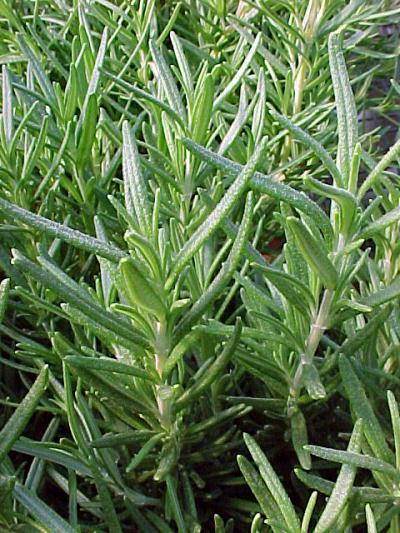 |
Rosemary,
Foresteri (Rosmarinus officinalis 'Foresteri')
Rosemary's past shows this
plant to be quite holy. Carried by people hiding from the
black plague, it was thought to ward off disease and
sickness. It was burned to purify the air in sick
chambers.
- Culinary:
Roasted poultry, fish, and meats are great with
the addition of rosemary. A minty pine taste
enhances all kinds of vegetables. Marinades,
vinegars, dressings and sauces.
- Medicinal:
The oil derived from the flowers and foliage is
considered a carminative. Used in pharmacies
today. The oil is also thought to help with pain,
bruises, wounds, and soars when gently massaged
into the wounded areas. Also has some
antibacterial effects to help in the fight
against germs.
- Aromatic:
The minty pine scent is very distinctive. Baths
are drawn with rosemary to help lift the spirits
and relax the body. Rosemary in clothes drawers
is said to deter moths and scent the clothes. Oil
is added to soaps, creams, and perfumes for its
pine scent.
- Ornamental:
Evergreen lance-shaped foliage gives a handsome
effect to the plant. A deeper green to the
foliage, and a bit more of a shine, than other
species of rosemary.
- Full Sun
- 3-6 feet in height.
- Makes an excellent
border plant. Easily trained.
- Tender perennial
- Well-Drained soil
|
| Image Soon |
Rosemary, Pink
(Rosmarinus officinalis 'Rosea') All the same properties as other upright
rosemary's, but a difference in color. Pink rosemary is
for those who prefer the difference from the other
rosemary's. Great for the perennial garden.
- Culinary:
Roasted poultry, fish, and meats are great with
the addition of rosemary. A minty pine taste
enhances all kinds of vegetables. Marinades,
vinegars, dressings and sauces.
- Medicinal:
The oil derived from the flowers and foliage is
considered a carminative. Used in pharmacies
today. The oil is also thought to help with pain,
bruises, wounds, and soars when gently massaged
into the wounded areas. Also has some
antibacterial effects to help in the fight
against germs.
- Aromatic:
The minty pine scent is very distinctive. Baths
are drawn with rosemary to help lift the spirits
and relax the body. Rosemary in clothes drawers
is said to deter moths and scent the clothes. Oil
is added to soaps, creams, and perfumes for its
pine scent.
- Ornamental:
Evergreen lance-shaped foliage gives a handsome
effect to the plant. Pink flowers decorate the
tops of this plant almost continuously throughout
the summer.
- Full Sun
- 3-6 feet in height.
- Gather most of your
rosemary stock just before flowering.
- Tender perennial
- Well-Drained soil.
|
| Image Soon |
Rosemary, Primly
Blue (Rosmarinus officinalis 'Primly Blue') |
| Image Soon |
Rosemary, Tuscan
Blue (Rosmarinus officinalis 'Tuscan Blue')
Larger foliage and faster
growth is what gives this species an edge over others. A
deep green color adds more of an interest to Tuscan Blue,
and it prctically grows straight upwards.
- Culinary:
Roasted poultry, fish, and meats are great with
the addition of rosemary. A minty pine taste
enhances all kinds of vegetables. Marinades,
vinegars, dressings and sauces.
- Medicinal:
The oil derived from the flowers and foliage is
considered a carminative. Used in pharmacies
today. The oil is also thought to help with pain,
bruises, wounds, and soars when gently massaged
into the wounded areas. Also has some
antibacterial effects to help in the fight
against germs.
- Aromatic:
The minty pine scent is very distinctive. Baths
are drawn with rosemary to help lift the spirits
and relax the body. Rosemary in clothes drawers
is said to deter moths and scent the clothes. Oil
is added to soaps, creams, and perfumes for its
pine scent.
- Ornamental:
Evergreen lance-shaped foliage gives a handsome
effect to the plant. Blue flowers decorate the
tops of this plant almost continuously throughout
the summer. Also known to be a bit taller than
the other species of rosemary.
- Full sun
- 5-7 feet in height.
- Wet soil promotes
root rot. Well drainage in essential.
- Tender perennial
- Well-Drained soil.
|
| Image Soon |
Rosemary, White
(Rosmarinus officinalis 'Alba') Another upright rosemary that holds it's
place in the garden for the white flowers it produces.
Mainly chosen over others for the buyers preference in
the color of flower. Just as attractive.
- Culinary:
Roasted poultry, fish, and meats are great with
the addition of rosemary. A minty pine taste
enhances all kinds of vegetables. Marinades,
vinegars, dressings and sauces.
- Medicinal:
The oil derived from the flowers and foliage is
considered a carminative. Used in pharmacies
today. The oil is also thought to help with pain,
bruises, wounds, and soars when gently massaged
into the wounded areas. Also has some
antibacterial effects to help in the fight
against germs.
- Aromatic:
The minty pine scent is very distinctive. Baths
are drawn with rosemary to help lift the spirits
and relax the body. Rosemary in clothes drawers
is said to deter moths and scent the clothes. Oil
is added to soaps, creams, and perfumes for its
pine scent.
- Ornamental:
Evergreen lance-shaped foliage gives a handsome
effect to the plant. White flowers decorate the
tops of this plant almost continuously throughout
the summer. Foliage is a bit thinner and lighter
than the other species.
- Full Sun
- 3-6 feet in height.
- Makes a great indoor
container plant.
- Tender perennial
- Well-Drained soil.
|
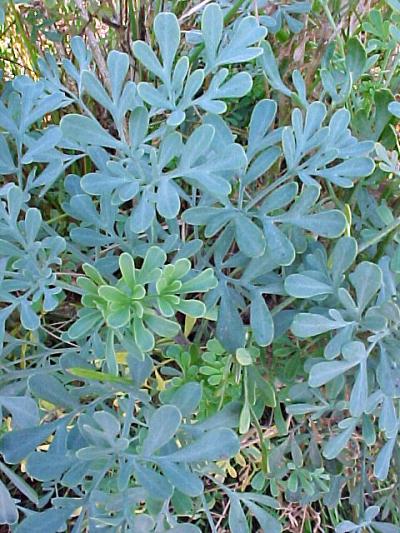 |
Rue (Ruta graveolens) This small
evergreen shrub plant is also known as the herb of grace.
It takes well to poor garden soil where it makes a
compact and attractive plant. The scent is somewhat
unique, and unpleasant to some. The shape of the leaf is
what the suit of clubs resembles.
- Medicinal:
In the past, Rue was believed to relieve
gas pains, and improved appetite. However, there
are no studies to prove these effects, and it is
wideley thought of as toxic. Caution to large
doses.
- Ornamental:
The blue-green foliage to the plant, and the
round lobed foliage are what this plant is mostly
grown for. Also, Yellow flowers from June to
August.
- Full
Sun
- 36
inches in height.
- Contact
to sensitive skin might cause blistering.
- Perennial.
Evergreen
- Well-Drained.
|
| Image Soon |
Sage, Berggarten
(Salvia officinalis 'Berggarten') A selection from Germany featuring
broad rounded leaves and a compact growth habit. An
attractive ornamental addition to the herb or even
perennial garden.
- Culinary:
Foliage is eaten fresh in salads, and cooked into
many types of foods. bread products, soups, meat
pies, maetloaf, marinades, and stuffings. Goes
great with vegetables
- Ornamental: Soft
and fuzzy greyish leaves make this plant
striking. Rounded foliage is compared to the
elongated foliage of other species. blue flowers.
- Full sun to part
shade.
- 16-20 inches in
height.
- Prune Sage plants
severely in the Spring. To demote seeding
- Perennial.
- Well-Drained and rich
soil.
|
| Image Soon |
Sage, Garden
(Salvia
officinalis) Garden Sage is a decorative evergreen shrub
with downy green foliage. Being the original of the
Sages. In ancient times, it was called the herb of
longevity. Yugoslavia still plants fields of sage for
consumption.
- Culinary:
Flowers may be used in salads, and
brewed for a tea. Foliage is cooked with meats,
and goes great in stuffing.
- Medicinal:
Sage helps in digestion. Tea helps with
coughs and colds. Also helps with diarrhea.
- Aromatic:
Sage is used in perfumes, and cosmetics. Even
some soaps. The smell of the foliage repels
flies, and some other insects.
- Full sun.
- 32 inches in height.
- Dried Sage has a
stronger, yet different flavor.
- Perennial
- Dry, Well-Drained
soil.
|
| Image Soon |
Sage, Gold
(Salvia officinalis 'Aurea') A golden contrast of Sage is what everyone
need in their garden. With all of the same qualities of
the Garden Sage, but with a pleasing addition for the
eye. A marvelous plant.
- Culinary:
Foliage is eaten fresh in salads, and cooked into
many types of foods. bread products, soups, meat
pies, maetloaf, marinades, and stuffings. Goes
great with vegetables.
- Medicinal:
Tea made from the leaf is an antiseptic and helps
with the blood and the nerves.
- Aromatic: Foliage
is aromatic with a strong scent. The scent of
Sage may be recognized when drifting through the
air.
- Ornamental:
Striking green and gold foliage please the eye.
The gold borders the leaf with a large band. The
compact foliage makes this a nice border plant.
- Full Sun
- 18 inches in height.
- Historically, Sage
does not grow too well next to onions.
- Perennial
- Well-Drained Soil
|
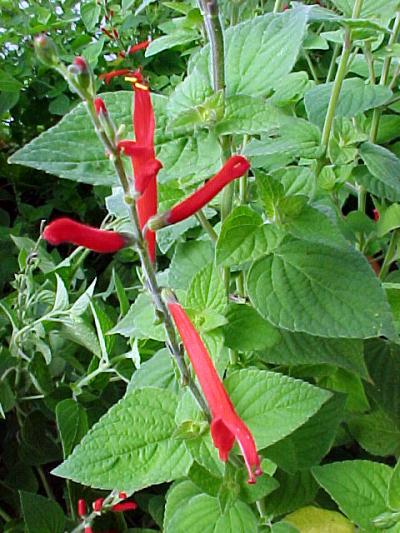 |
Sage, Honeymelon
(Salvia elegans 'Honeymelon') More of an upright grower, this Sage is
somewhat different from most of the other sages. The
height, and the beauty of the brilliant red flowers, make
this Sage and attractive bush-like plant.
- Culinary:
- Ornamental: The
scarlet red flowers are a major attractions to
butterflies, and hummingbirds. Heart-shaped
leaves. Cut flowers are great in vases or as a
garnish.
- Aromatic:
The scent of the honey dew melon is a delicious
addition the the plants qualities. A must smell.
- Full Sun
- 24 inches in height.
- Keep from cold.
- Tender perennial
- Well-Drained soil
|
| Image Soon |
Sage, Pineapple
(Salvia elegans) A
close relative of the Honeymelon Sage, but a bit larger
and a different scent. Elongated leaves with a fine point
also helps differ the two. this plant will get your mouth
watering. Pineapple Sage also makes a wonderfull indoor
plant.
- Culinary: ?
- Ornamental: Beautiful
red flowers from late-summer to fall give this
plant remarkeable ornamental values. Nicely
pointed leaves, and a bush-like shape to the
plant make it nice in the house. Even without the
flowers.
- Aromatic:
Delicious pineapple flavored aroma will fill the
air if walked by or brushed upon.
- Full Sun
- 36 inches in height.
- Keep from cold.
- Tender Perennial
- Well-Drained soil.
|
| Image Soon |
Sage, Purple
(Salvia officinalis 'Purpurea') A compact form of officinalis. This herb has
the same habits as the Gold Sage and is just as
attractive. Leather-like foliage makes most sages
familiar to the eye.
- Culinary:
Foliage is eaten fresh in salads, and cooked into
many types of foods. bread products, soups, meat
pies, maetloaf, marinades, and stuffings. Goes
great with vegetables.
- Medicinal:
Tea made from the leaf is an antiseptic and helps
with the blood and the nerves.
- Aromatic: Foliage
is aromatic with a strong scent. The scent of
Sage may be recognized when drifting through the
air.
- Ornamental: Purple
foliage and a compact, dense growth habit makes
this a great border plant.
- Full Sun
- 18 inches in height.
- Sage and Rosemary are
great companions.
- Perennial
- Well-Drained Soil.
|
| Image Soon |
Sage, Russian
(Perovskia atriplicifolia) Mostly known for its ornamental values as a
perennial plant. The unique aromatic and ornamental
features of this plant make it an interest to all. 1995
Perennial Plant of the Year.
- Aromatic: A
characteristic scent to the foliage is quite
intriguing. Bruise the foliage and it increases
in scent.
- Ornamental:
Grey-green foliage topped with masses of striking
blue elongated flower spikes makes this plant a
popular veteran to many gardens.
- Full Sun
- 36-48 inches in
height.
- Cut back when the
plant begins to look unpleasing to the eye.
- Perennial
- Well-Drained Soil
|
| Image Soon |
Sage, Tri-Color
(Salvia officinalis 'Tri-Color') Keeping up with the other colored sages(gold
and purple), Tri-Color Sage is also very striking in
appearance. Not just one or two colors, but, of course
three. Not as compact or dense in growth.
- Culinary:
Foliage is eaten fresh in salads, and cooked into
many types of foods. bread products, soups, meat
pies, maetloaf, marinades, and stuffings. Goes
great with vegetables.
- Medicinal:
Tea made from the leaf is an antiseptic and helps
with the blood and the nerves.
- Aromatic: Foliage
is aromatic with a strong scent. The scent of
Sage is characteristic, and may easily be
recognized when drifting through the air.
- Ornamental:
A very decorative herb with the cream colored
variegation along with purple and green.
- Full Sun
- 24-36 inches in
height.
- Cut back after
flowering
- Perennial
- Well-drained Soil.
|
| Image Soon |
Salad Burnet
(Poterium sanguisorba) This forgotten herb used to be highly
preferred for a taste of cucumber in your salad. The
Sixteenth Century popularized this herb as bieng high in
medicinal value.The herb has dissapeared from the uses in
which it was once generously used.
- Culinary:
The foliage has the taste of cucumbers, but the
older leaves are bitter in taste, so stick to the
young foliage.Salads and coleslaw are the two
biggest uses for the leaves. Also found in some
cheeses and soups.
- Medicinal:
Foliage contains vitamin C, and helps aid in
digestion. Once thought to heal wounds by
bringing the two sides of the cut together and
sealing it. Used to relieve hemmorhoids and
diarrhea.
- Ornamental:
Small green flowers with red tips appear in
mid-summer. The foliage suggests this herb as a
nice edging plant.
- Full Sun to part
shade.
- 12-24 inches in
height.
- Burnet does not dry
well. It will lose it's taste.
- Perennial
- Well-Drained soil
|
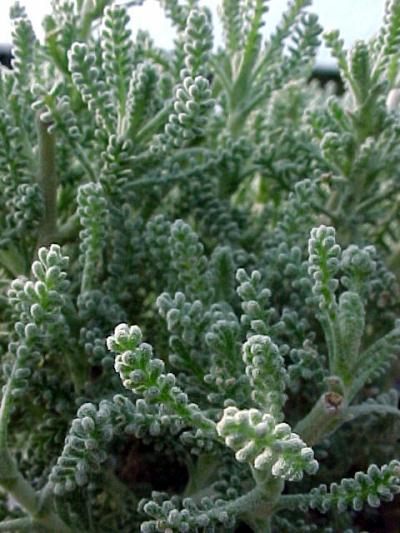 |
Santolina,
Compactum (Santolina chamaecyparissus) A smaller and tighter version of
Grey Santolina. More valuable in ways for it's compact
habit. Originating in the Mediterranean. Medicinal in the
past, but presently Ornamental.
- Aromatic:
The foliage is added to potpourri for the musky
scent it emits. Foliage deters insects.
- Ornamental:
Silverish, fern-like foliage makes this plant
fantastic for borders. Neatly trimmed. Bright
yellow buttons top the feathery foliage in June
and July.
- Full Sun
- 12-24 inches in
height.
- Do not take
internally.
- Perennial
- Well-Drained soil.
|
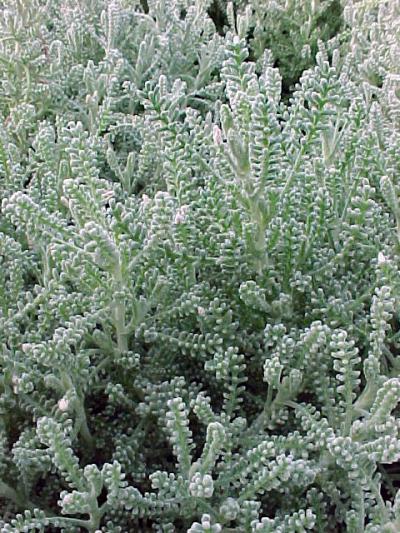 |
Santolina, Grey
(Santolina chamaecyparissus) Native to the Mediterranean, this herb was
once used for medicinal purposes. Once thought to kill
worms, it is no longer thought of as medicinal, but
highly used for it ornamental properties.
- Aromatic:
The foliage is added to potpourri for the musky
scent it emits. Foliage deters insects.
- Ornamental:
Silverish, fern-like foliage makes this plant
fantastic for borders. Neatly trimmed. Bright
yellow buttons top the feathery foliage in June
and July.
- Full Sun
- 18-24 inches in
height.
- Do not take
internally.
- Perennial
- Well-Drained soil.
|
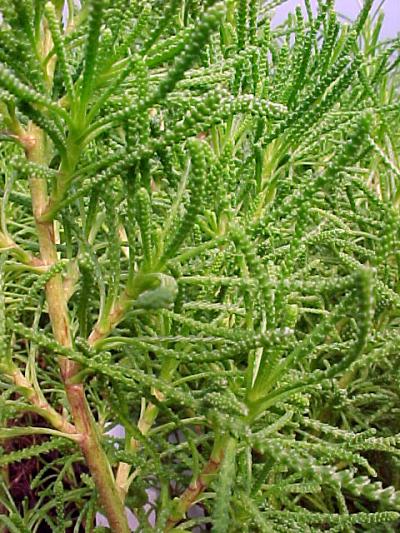 |
Santolina, Green
(Santolina virens) Practically
identical to the Grey Santolina, but with green foliage.
Used to sweeten the air in Mediterranean regions for
ages. Makes a great border plant, and was famous in the
past for its use in knot gardens.
- Aromatic:
The foliage is addd to potpourri for the musky
scent it emits. Foliage deters insects, and
sprigs are used in clothes drawers for moths.
- Ornamental:
Silverish, fern-like foliage makes this plant
fantastic for borders. Neatly trimmed. Bright
yellow buttons top the feathery foliage in June
and July.
- Full Sun
- 18-24 inches in
height.
- Do not take
internally.
- Perennial
- Well-Drained soil.
|
| Image Soon |
Savory, Creeping
Winter (Satureja montana 'Repanda') A mat of bright green leaves is
formed by this evergreen subshrub. Used for over 2,000
for its flavor addition to food. At one time, savory was
the highest in flavor for the time it was in. Therefore
it's rise in popularity was easily explained.
- Culinary:
A stronger flavor than it's brother, Summer
Savory. Used with meats, and especially popular
with beans. Flavors vinegars, and may be
sprinkled on soups and stews.
- Medicinal:
Foliage is crushed and added to bites and stings
for temporary pain relief. Tea is used for
diarrhea, appetite problems, and sore throats.
- Full Sun
- 3 inches in height.
- Dried leaves are
available comercially.
- Perennial
- Light, Well-Drained
soil.
|
| Image Soon |
Savory, Summer
(Satureja hortensis) Native to the Mediterranean, it was
much in demand in early Rome where it was thought to be a
powerful aphrodisiac. Almost identical to its brother,
Winter Savory, but a bit milder in taste.
- Culinary:
Meats, beans, and vinegar are major uses for this
herb. used with the majority of vegetables, and
popular in stews.
- Medicinal:
Foliage is crushed and added to bites and stings
for temporary pain relief. Tea is used for
diarrhea, appetite problems, and sore throats.
- Full Sun
- 12-18 inches in
height.
- Dried leaves are
available comercially.
- Annual
- Average soil
|
| Image Soon |
Savory, Winter
(Satureja montana) A
darker and firmer foliage than Summer foliage. Almost
identical in all application except for the hardiness in
the garden. Almost entirely used for their culinary
values today.
- Culinary:
A stronger flavor than it's brother, Summer
Savory. Used with meats, and especially popular
with beans. Flavors vinegars, and may be
sprinkled on soups and stews.
- Medicinal:
Foliage is crushed and added to bites and stings
for temporary pain relief. Tea is used for
diarrhea, appetite problems, and sore throats.
- Full Sun
- 6-12 inches in
height.
- Dried leaves are
available comercially.
- Perennial
- Light, Well-Drained
soil.
|
| Image Soon |
Shallots (Allium
cepa) Shallots is a
form of Onion. Mainly grown for it culinary
characteristics, it is commonly overlooked for its
medicinal, and ornamental properties. Dating way back to
the Egyptian times, Shallots were drawn on the walls of
Egyptian tombs as one of the most popular plants of their
time.
- Culinary:
There are so many uses for the onion, that it is
impossible to list them all. A great addition to
almost all food in many shapes and forms. Most
people are very familiar with the culinary uses
of the onion.
- Medicinal:
Contains small doses of Anti-bacterial
components. Helps in blood pressure, and also
helps reduce the buildup in arteries. A paste may
be put on small burns and wounds to speed up the
healing process.
- Ornamental:
Generally speaking, the onion (allium) family is
quite ornamental. Throwing round pink flowers in
the air form June to August. Thay are frequently
dried for arrangements.
- Full Sun
- 8-12 inches in
height.
- Mildest onion,
sweetest taste.
- Perennial
- Well-Drained soil.
|
| Image Soon |
Skullcap (Scutellaria
lateriflora) Oval
toothed leaves and pretty blue flowers add a bit of
ornament to this medicinal herb. Native to East Asia.
Most popular for it's root.
- Medicinal:Once
given for epilepsy and rabies, this herb is said
to calm the nerves. Also a sedative. Root is
given in Asia for respiratory and digestive
problems.
- Ornamental:Oval
toothed leaves and pretty blue flowers add a bit
of ornament to this herb.
- Light Shade
- 36 inches in height.
- Large doses may cause
giddiness, and confusion.
- Perennial
- Well-Drained Soil
|
| Image Soon |
Sorrel
(Rumex acetosa) Grown
mainly for its culinary uses. The wild version of this
plant is what is grown for the medicinal purposes. Sorrel
is high in vitamins, and benifits all in more ways than
one.
- Culinary:
High in acidity, the foliage is added to salads
to reduce acid in dressing and other vegetables.
The young foliage is tender, but not as strong in
taste. As the season progresses, the acidity
increases.
- Medicinal:
Foliage makes a tea which is used for the kidney
and liver. Root makes a mild laxative.
- Full Sun to light
shade
- 24-48 inches in
height.
- Juice is so acidic,
it may be used for stains and mold.
- Perennial
- Average soil
|
| Image Soon |
Southernwood
(Artemesia
abrotanum) The
French call it garde-robe because they use it in
wardrobes to ward off moths. Also used in perfumes and
potions to earn itself a name called 'Lovers' Plant'.
Used for it's strong scent in the past for many purposes.
- Medicinal:
Infuse as a tea for a tonic to give to children
to dispel worms. Foliage is also added to
bathwater for skin conditions.
- Aromatic:
The sweet, strong lemon fragrance of the foliage
earns it a place in many potpourris. Deters moths
and other insects. Foliage added to a bath is
soothing and relaxing. The scent was once used to
keep people awake during boring church
ceremonies.
- Ornamental: Soft
and feathery grey foliage makes a great contrast
in many gardens.
- Full Sun
- 36 inches in height.
- Needs pruning in the
spring to keep it in good looking shape.
- Perennial
- Well-Drained soil.
|
| Image Soon |
Stevia (Stevia
rebaudiana) This
tropical annual gained it's fame from the sweetness it
witholds.
- Culinary: Leaf
powder is a substitute for sugar in all aspects.
|
| Image Soon |
St. John's Wort (Hypericum
perforatum) In the
past, this plant was highly known as a very supersticious
herb. The look of bleeding when crushed may have been the
reason for this. High in medicinal value.
- Medicinal:
The dye derived from this herb are thought to be
an antidepressant. Bruises and hemerrhoids react
to this plant.Tea is made for headaches, and
nervous problems.
- Full sun to part
shade
- 24 inches in height
- Pich flowers and they
turn red.
- Perennial
- Average soil
|
| Image Soon |
Strawberry (Fragaria) |
|
Strawberry,
Alpine (Fragaria vesca) |
| Image Soon |
Sweet Annie (Artemesia
annua) |
| Image Soon |
Sweet Cicely
(Myrrhis odorata) Fern-like
foliage. Frequently overlooked my most gardners. Gives a
nice ornametal view to the landscape. Fruit appears in
early summer. Botanical name was derived from a greek
word meaning perfume.
- Culinary: A
mild anise like flavor. Add chopped foliage to
soups, stews, and omelletes. Seeds have sweet
flavor and are used in candy, syrup, and liquor.
Root may be steamed.
- Medicinal:
Foliage is a sweetener and used ffor diabetics.
Boiled root strengthens the elderly. The plant
increases appetite and decreases flatulance.
Plant is made into a furniture polish.
- Ornamental: The
fern-like foliage topped with white flowers in
spring make it an attractive perennial plant.
- Light shade
- 30-36 inches in
height.
- Harvest roots in
Autumn
- Perennial
- Rich soil
|
| Image Soon |
Sweet Woodruff (Galium
oderatum) Related to
the Bedstraws, the foliage of this groundcover has the
scent of hay. That is until you dry them, and the sweet
smell of Vanilla scents the air. Hung to dry in churches
for ceremony.
- Culinary: Foliage
goes great with wine. Also makes a tea.
Non-edible.
- Medicinal:Tea
was said to calm the stomach. Foliage applied
directly to wounds.
- Aromatic:
Foliage used in potpourris and perfumes. Nice
Vanilla flavor. Also used in herb pillows.
- Ornamental:
Beautiful symetrical star-like foliage, topped
with white star flowers in May and June.. Real
nice groundcover for shady places.
- Shade.
- 8-12 inches in
height.
- Likes moist, wooded,
shady locations.
- Perennial
- Moist, Well-Drained
soil.
|
| Image Soon |
Tansy, Fernleaf
(Tanacetum vulgare) With
a long written history through time, this herb supposedly
dates back to greek mythology. With the amount of uses
this herb offers, it is no wonder why.
- Culinary:
Foliage is rubbed into meats for flavor. Used in
stuffings, meats, and pies. Strong peppery flavor
is popular in breakfast cooking. Use in
moderation.
- Medicinal:
Medicinal in the past, but recently set aside
because of it's toxicity. Replacements are safer.
- Ornamental:
Lush tropical foliage. Yellow flower heads from
July to September.
- Aromatic: Foliage
emits a pine flavored scent when brushed against.
Thought to deter insects.
- Full sun to Part
Shade.
- 3-4 feet in height.
- Watch the growth. May
become invasive.
- Perennial
- Average soil.
|
| Image Soon |
Tarragon, French
(Artemesia dracunculus sativa) Largely cultivated for it's culinary
properties, and a necessity in the kitchen. Not popular
for medicinal purposes, but thought to have them as well.
- Culinary: Popular
in France. Foiliage may be added to salads,
stuffings, sauces, dressings. Don't cook too
long, for it will become bitter. Enhances the
flavor of most meats, poultry, and vegetables.
- Medicinal:
Thought to help appetite, and relieve flatulance.
No scientific base.
- Full Sun to Part
Shade.
- 18-24 inches in
height.
- Flower stems should
be removed to insure a productive plant.
- Perennial
- Rich, Well-Drained
soil.
|
| Image Soon |
Tarragon, Mexican
(Tagetes lucida) Bieng
the best substitute for French Tarragon, it is more
popular ornamentally. Double bloomed yellow flowers make
it spectacular to add to any garden where French Tarragon
will not grow.
- Culinary: Substitute
for the uses of the French Tarragon in salads,
meats, poultry and stuffings.
- Medicinal: Makes
a stimulating tea.
- Aromatic: Foliage
and flowers have a sweet smell. Also known as
'Sweet Marigold'.
- Ornamental:
Yellow, double-bloom marigold flowers.
- Full Sun
- 24-36 inches in
height.
- ?
- Tender Perennial
- Well-Drained soil
|
| Image Soon |
Thyme, Caraway
(Thymus herba-barona) Long trailing stems and small green leaves
that give off an interesting scent when bruised. Culinary
as well as ornamental. Bright pink flowers.
- Culinary: Used
largely in Fish, meats, and popular with
vegetables. Adds exceptional flavor to beef.
- Medicinal: Thyme
has allways been used as a preservative, and is
still used in imbalming fluid to this day.
- Ornamental: The
showy pink flowers and dark green foliage makes
this Thyme a nice looking groundcover.
- Aromatic:
A caraway scent proves the flavor that it will
add to dishes.
- Full Sun
- 4 inches in height.
Creeper.
- Pick leaves in
summer.
- Perennial
- Well-Drained Soil.
|
| Image Soon |
Thyme, Coconut (Thymus
praecox) Large
round leaves on stems that arch upright make this plant
large for most Thymes.
- Aromatic: A
mild scent of Coconut from the foliage. Popular
for bees and some other insects.
- Ornamental: Evergreen
foliage, and purple flowers. Creates a thick
ground mat.
- Full Sun.
- Creeper
- Adds flavorous scent
to cheeses.
- Perennial
- Well-Drained soil.
|
| Image Soon |
Thyme, Doone
Valley (Thymus citriodorus 'Aureus') Thyme has been well known through
history as an antiseptic and preservative. This Thyme is
especially popular for it's scent and variegation.
- Culinary:
Lemon flavor makes this Thyme an excellent base
for a honey tea. Great with fish, meats, and
wonderful in sauces.
- Aromatic: Lemon
scent to the foliage makes it all that much more
valuable.
- Ornamental: Splashes
of gold variegation, and pale purple flowers make
this Thyme striking in the garden.
- Full Sun
- 3 Inches in height.
- Variegation is
stronger in cooler weather.
- Perennial
- Well-Drained soil.
|
| Image Soon |
Thyme, Doretta
Klaber (Thymus minus 'Doretta Klaber') |
| Image Soon |
Thyme, English
(Thymus vulgaris) The
original common Thyme. The Greeks enjoyed Thyme to the
fullest, and used the oil for afterbath massages. Plant
begins to get woody after it's first year of growth.
- Culinary:
Marinades, stuffings, soups, stews, and sauces.
Also good with poultry and shellfish. The
strongest flavor comes from the young fresh
leaves.
- Medicinal: Oil
derived from the plant is beneficial. Used
externally for depression, headaches, colds,
muscular pains, acne,and used in mouthwashes.
Research says that Thyme will strengthen the
immune system.
- Ornamental:
Lilac flowers atop deep green foliage always
makes Thyme an attractive groundcover.
- Full Sun
- 12-15 inches in
height.
- Leaves are best when
plant is in bloom.
- Perennial
- Well-Drained soil.
|
| Image Soon |
Thyme, Gold
(Thymus serpyllum 'Aureus') A low mounding thyme with golden foliage and
rose-purple flowers. Great as an ornamental or in the
making of herbal tea.
- Culinary:
Tea is made from the foliage.
- Ornamenal:A
creeping habit of golden foliage will add
interest to your garden. Great mixed with other
thymes for the overall effect. Purple-Rose
flowers add great contrast to the foliage.
- Medicinal:
Reduced indigestion and flatulance. Tea helps to
calm nerves, and treats the flu, and coughs.
- Full Sun
- Creeper
- Without strong sun,
the bright golden color will fade.
- Perennial
- Well-Drained soil.
|
| Image Soon |
Thyme, Gold Edge
Lemon (Thymus x citriodorous 'Aureus'') This upright grower has brilliant
yellow and green variegated foliage when grown in full
sun. Popular in aromatherapy.
- Culinary: Lemon
flavored thyme always goes good with seafood and
poultry. Adds flavor to sauces as well.
- Medicinal: Aromatherapy
helps keep the head straight and mind clear.
- Aromatic: Strong
lemon scent to the foliage. Especially when
bruised or crushed.
- Ornamental:
The foliage is striking. Gold and green
variegation as especially attractive when grown
in full sun.
- Full sun
- 8-12 inches in
height.
- Less tolerant to the
cold than most Thymes.
- Perennial
- Well-Drained soil.
|
| Image Soon |
Thyme, Golden
King (Thymus var. 'Golden King') This creeping thyme has a wonderful
variegation splashed throughout it's foliage. New to the
family of thymes, it shall reserve it's place in the
garden for many. Good substitute for 'Doone Valley'
Thyme.
|
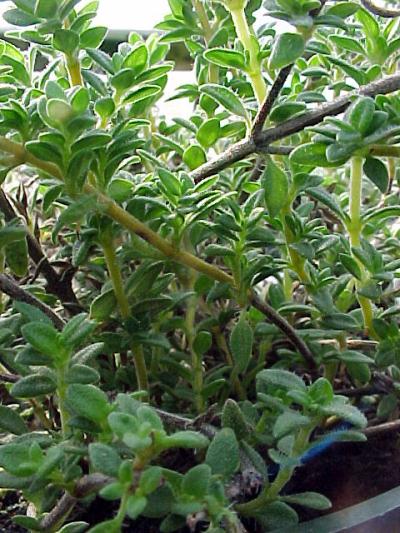 |
Thyme, Lavender
(Thymus var. 'Lavender') Perennial. Low-mounding thyme with a
lavender scent. Ornamental, potpourri or low edging
plant.
|
| Image Soon |
Thyme, Lemon
(Thymus x 'Citriodorus') Low-growing thyme that makes a nice
groundcover. Leaves emit a strong lemon scent when
crushed. Bright pink flowers in summer.
|
| Image Soon |
Thyme, Orange
(Thymus citriodorus 'Fragrantissimus') Sensational orange scent and
flavor. Derserving of experimentation in tea, and
cooking. A favorite among West Indians.
- Culinary:
Cirus orange flavor add interest to fish and game
meats. great with poultry. Makes a flavorfull
tea. Nice addition to fruit salads.
- Aromatic: Orange
flavor will fill the air. Especially strong when
crushed or bruised.
- Ornamental:
Blue-grey foliage topped with pale lilac flowers.
- Full Sun
- 8-12 inches in
height.
- ?
- Perennial
- Well-Drained soil.
|
 |
Thyme, Oregano
(Thymus pulegiodes) Low-mounding
herb with unique oregano scent to shiny foliage.
Ornamental, and culinary. Deep lavender flowers in
summer.
- Culinary: Long
slow cooking of soups and stews is perfect for
thyme. Strong oregano flavor.
- Ornamental:
Large broad leaves are larger than the average
Thyme. Shiny foliage helps in ornamental value.
- Aromatic:
Strong oregano scent adds aroma to favorite
dishes, and sauces.
- Full sun
- 8-12 inches in
height.
- ?
- Perennial
- Well-Drained soil.
|
| Image Soon |
Thyme, Pink (Thymus
serpyllum 'Rosea') |
| Image Soon |
Thyme, Red (Thymus
praecox 'Coccineus') Beautiful
groundcover with small, shiny hairy foliage. Leaves
darken with the cold of the season.
- Ornamental:
Bright red flowers and hairy foliage add
ornamental properties to this attractive
groundcover. Flagstones and walkways are perfect
for this herb.
- Full Sun
- Creeper
- Tolerates foot
traffic.
- Perennial
- Well-Drained soil.
|
| Image Soon |
Thyme, Silver
Edge (Thymus praecox 'Argenteum') Perennial. Low mounding habit, with
a very attractive silver edge on its leaves. Ornamental.
|
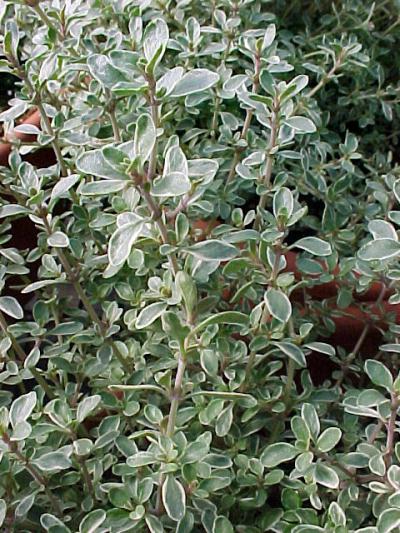 |
Thyme, SIlver
Edge Lemon (Thymus x citriodorus 'Silver Edge')
Discovered as a sport off
of Gold-Edge Lemon Thyme. Leaves are a silvery-green with
bright yellow edges. Pink flowers in summer. Low mounding
habit. Nice attraction.
- Culinary: Lemon
flavored thyme always goes good with seafood,
poultry, and fish. Great with sauces as well.
- Aromatic: Strong
lemon scent to the foliage. Especially when
bruised or crushed.
- Ornamental:
The foliage is striking. Silver and green
variegation is especially attractive when grown
in full sun.
- Full Sun
- 8-12 inches in
height.
- Not as tolerant to
the cold.
- Perennial
- Well-Drained soil.
|
| Image Soon |
Thyme, White (Thymus
praecox 'Albus') Evergreen
mat covers slopes and rock gardens. Covered with white
flowers in late spring.
- Ornamental:
Emerald foliage with white flowers. A bright
looking groundcover.
- Full Sun
- Creeper
- ?
- Perennial
- Well-Drained soil.
|
| Image Soon |
Thyme, Woolly (Thymus
pseudolanuginosus) Evergreen
mat covers slopes and rock gardens. Covered with pink
flowers throughout summer.
- Ornamental:
Dusty grey foliage covered with fine hairs
attractively covers the ground .Pink flowers aid
in ornament throughout the summer.
- Full Sun
- Creeper
- Keep dry. Too much
moisture will rot the plant.
- Perennial.
- Dry, Well-Drained
soil.
|
| Image Soon |
Valerian, Red (Valeriana
officinalis) |
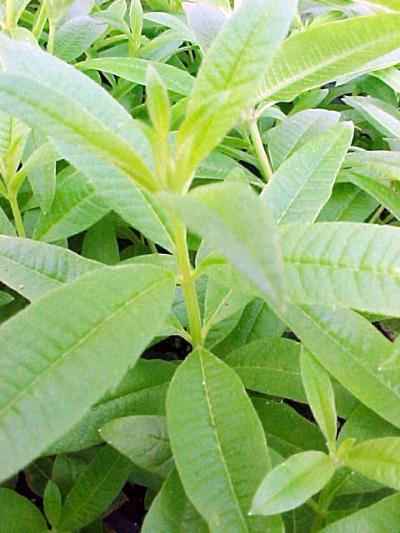 |
Verbena, Lemon
(Aloysia triphylla) A
tender perennial or pot plant with loing narrow leaves
that give off a strong lemon scent and are frequently
used in potpourris. A native of South America, it grows
to 2-4' except in greenhouses where it may reach 15'.
|
| Image Soon |
Watercress
(Nasturtium officinale) Biennial. A delicious vegetable. It prefers
wet area., Low growing, its leaves are best harvested
before the flowers occur. Used in salads, sandwiches,
soups and as a garnish. High Vitamin content.
|
![]()
